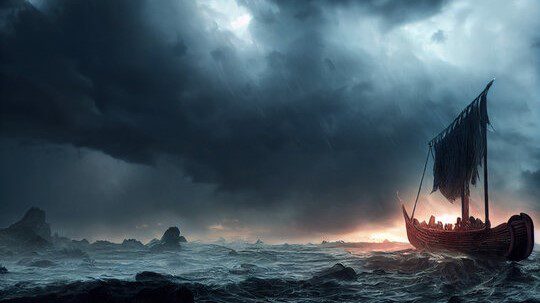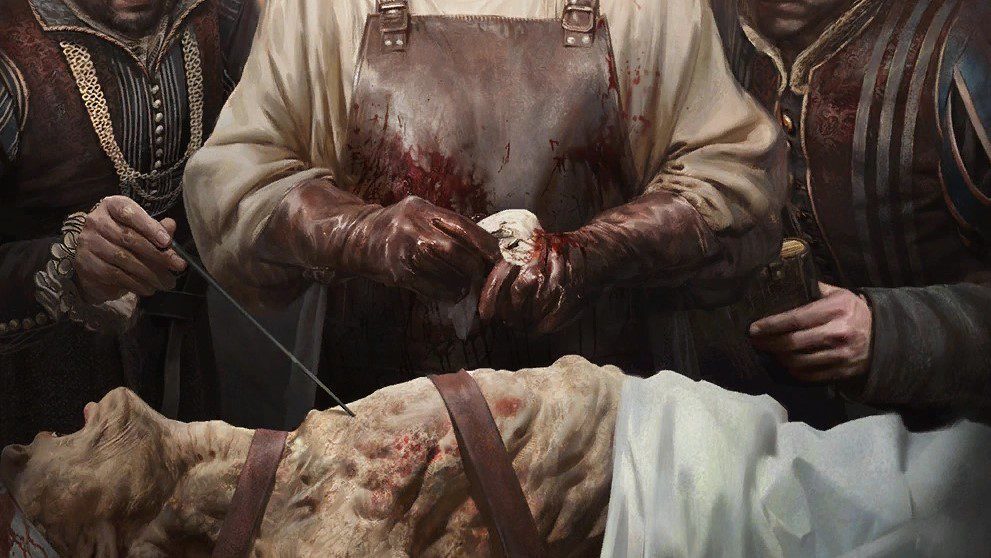The Lore and History of The Witcher Novels Part 2: The First Witcher
Check out part 1 of this breakdown here.
THE FIRST LANDING | 760s AR

Once the chaos of The Conjunction of the Spheres had subsided, the elves regained control of the Continent, reclaiming their position as the dominant species. Though wars and conflicts abounded in the millennia following the Conjunction, the elves did not consider these early humans much of a threat. Without magic, alliances, technology, or strongholds, the Dauk and Wozgor posed little danger to the elves, who had not yet noticed their devolution. The elves were still mighty and like unto angels, so what could languageless savages hope to do in opposition to their power?
That all changed upon The First Landing. Humans may have populated the Continent for nigh on a millennium at this point, yet the realms and kingdoms that epitomized the land at the time of Geralt only began to form 500 years before his time. Four ships hailing from unknown lands set ashore near the same beach where the elves first arrived in the Pontar Delta, where the river Yaruga ends. The history and origin of these men are shrouded in mystery, yet they are known as exiles above all else. Despite this, some scholars believe these Nordlings were the descendants of humans who arrived in the Isles of Skellige at the time of the Conjunction.
This First Landing of Nordlings, or The Landing of the Exiles, saw the birth of human society, beginning its rise to prominence and eventual dominion. The elves did not recognize the threat that these Nordlings posed for many years, their hubris blinding them to their own devolution caused by the Conjunction and to the threat posed by the ever-breeding and expanding human species.
Beyond the arrival of these exiles, a far more valuable discovery came in tandem with The First Landing. Aboard the Ship of Outcasts arrived one of the most pivotal men in human history. As the ships of Nordlings approached the shores of the Pontar Delta, a great storm and assault of the sea threatened to dash this burgeoning society upon the rocks and end this new era before it began. It is believed that Jan Bekker saw the chaos of the sea and felt the pull of the natural force of the world. Jan wielded this chaos to calm the seas and gently guide The Exiles to shore. This is considered by many the first use of the elder races’ magic by a human. This newfound ability became a crucial tool in the rise of humanity, the development of their burgeoning society, and the eventual war against and subjugation of the elder races. Jan would go on to participate in many crucial human events, such as the rise of Novigrad and the founding of the Brotherhood of Sorcerers.
THE RISE OF HUMANITY | 760s – 950 AR

Humanity thrived in the coming centuries, dominating in countless wars between themselves and the elder races. They overtook ancient elven and dwarvish settlements and built cities, spreading across the entire Continent and the lands beyond. Scholars, inventors, and mages of every kind helped construct this new society, skyrocketing its development far into the future. Never has a race or civilization accelerated so quickly in so short a span, becoming a contender for dominion in its own right.
It was not long until the elves recognized the threat that this new species and civilization posed. Yet, it was too late; the symptoms of the strange devolution among the Aen Seidhe, which began at the Conjunction, first became apparent. Their magical and ethereal excellence diminished, the species itself devolving in tandem with the devolution of their society. It was not long until they were little more than long-lived humans with pointy ears. This allowed the humans to wrestle control and dominion of the Continent away from them, leading to centuries of race wars and distrust.
The primary theory for this devolution centers around the effect that the Conjunction had. As the only race on the Continent with any innate multiversal abilities, the elves drew power from the closeness of the spheres and universes. As the spheres separated post-Conjunction, the spheres ever further apart, so too did the power of the elves fade away. It is believed if another Conjunction ever occurs, its arrival will be heralded by a resurgence of elven magic and dominion.

During the rise of humanity, in their parallel world, the Aen Elle determined a slave force was necessary to develop their own society. Either born from wartime need against the unicorns or a general aversion to menial labor, the king’s elite guard, led by the ambitious Eredin, formed the Wild Hunt. Dressed in ghastly armor, wielding ghostly magic, and commanders of the snowy elements, the Wild Hunt would traverse the multiverse to kidnap humans for slave labor. Their terrifying appearance and abilities led many to believe they were wraiths rather than elves. Years later, mountains of human bones were discovered in proximity to the Aen Elle city of Tir ná Lia. It is unknown whether these humans were previous inhabitants of this world or the remains of the slaves kidnapped by the Wild Hunt. The Wild Hunt even visited the world of their elven brethren, the Aen Seidhe, in search of human slaves. However, they found something far more frightening.
In these incursions to the Continent, The Aen Elle discovered two things. The first was the revelation that the world of the Aen Seidhe, the Continent, moved at a much quicker rate than that of the Aen Elle. While only a few centuries since the Conjunction had passed for the Aen Elle, over a millennium had passed for their brethren. In tandem with this discovery came a second, far more terrifying one; they witnessed the Aen Seidhe’s devolution. Because of their choice of homeworld, the Aen Elle got a glimpse into their evolutionary future, and it frightened them. The primary change with this devolution that concerned the Aen Elle was the rapid loss of multiversal travel abilities. If any doom came for Tir ná Lia, they would not be able to pick up and immigrate to a new world as they had done before. Instead of accepting their fate as the Aen Seidhe were forced to do, the Aen Elle went to work.
The Elder Bloodline was always the strongest manipulators of the multiverse, so experimentation on this deviation began. Selective breeding and genetic explorations started to see if the abilities of the Elder Blood could be strengthened, transferred, or fortified against any coming doom. According to game lore, the Aen Elle knew that the multiversal threat of The White Frost was rampaging through the universes and would one day soon come for Tir ná Lia.

Back in the Continent, the fears of the Aen Elle were soon justified with Ithlinne’s Prophecy. Ithlinne was a renowned elven healer and oracle. Many of her smaller prophecies were proved correct in the millennia following her death, including the prediction of the Northern Wars of 1239 through 1268 AR and several widespread plague epidemics of later years. Yet, one prophecy of hers stands out above the rest: a prophecy of ice and destruction and the end of the world by way of The White Frost. It is heavily disputed whether or not much of this prophecy references the coming heir of the Elder Blood, Ciri. Regardless, enough people believed that Ciri was a central figure in this prophecy, leading many factions of both men and elves to search for the young girl for either their own purposes or in hopes of saving the world from the coming White Frost.
The books maintain that this prediction is of an Ice Age that would overcome the Continent several thousand years after the time of Ciri. However, the games claim Ithlinne’s Prophecy referred to a multiversal destructive force that only Ciri could keep at bay.
“Verily I say unto you, the era of the sword and axe is nigh, the era of the wolf’s blizzard. The Time of the White Chill and the White Light is nigh, the Time of Madness and the Time of Contempt . . . the Time of End. The world will die amidst frost and be reborn with the new sun. It will be reborn of Elder Blood, of Hen Ichaer, of the seed that has been sown. A seed which will not sprout but burst into flame. Ess’tuath esse! Thus it shall be! Watch for the signs! What signs these shall be, I say unto you: first the earth will flow with the blood of Aen Seidhe, the Blood of Elves…”
These words affected many over the centuries, instigating great wars and atrocities for fear of the coming doom. Even in the distant world where Tir ná Lia stood, the Aen Elle shivered in fear upon hearing this prophecy.
THE TIME OF THE WITCHERS | 950s – 1160s AR

Humanity may have been set upon an upward path toward dominion over sentient life on the Continent, but dominion over non-sentient life was another matter entirely. The foul beasts and monstrous creatures that arrived at the time of the Conjunction still rampaged throughout the land, slaughtering whole villages and towns at a whim. Humanity was far too ill-equipped to handle such calamitous beasts as griffins, draconids, and leshy. Great fortresses and castles were built to hold back the monstrous assault, keeping the rich and powerful safe for the time being. Nevertheless, a solution was necessary, or the burgeoning race of humanity could not endure much longer.
After over a millennium of monster infestation of the Continent, the rulers of the Northern Realms demanded a solution from the mages. A new cast of magic-wielding warriors seemed the best defense against the horrors of the dark. This demand fell upon the shoulders of mystic master Cosimo Malaspina and his young pupil Alzur. Despite the vast wisdom Cosimo possessed, age had caught up to him, leaving the lion’s share of effort in the capable hands of his apprentice.
Secluding themselves in Castle Rissberg, the sorcerers set to work, willing to do whatever it takes for the greater good and the art necessary to accomplish their goals. The deeds and experiments of these men went down in history as some of the most horrific and inhumane studies ever conceived. Making these deeds all the more abhorrent, the subjects of these experiments were the young, children malleable enough to accept the genetic mutations. The first group of test subjects was comprised of 38 youths, all under the age of 10. Of the 38 boys and girls subjected to these mutations, only five of the boys endured the torture. Even the most dastardly and villainous of the Northern rulers looked upon what the mages had wrought in terror, their stomachs churning at the sight. Never had children been so desecrated. Some even believed that whatever innate humanity accompanied birth had been rooted out and burned to satisfy some sick and twisted fascination of the men perpetuating these horrors.
Men may be afraid of whatever foul beasts stalk the night, yet they are more frightened of what monstrosities they themselves could become. Not only were these experiments horrendous and an affront to common decency, but they were also generally considered to be abject failures. While these surviving boys were capable of great feats of strength, their magical abilities were muted and unimpressive at best. This failure was enough for the united kings to put an end to these experiments, decreeing that never again should such heinous atrocities be committed.

The art of their craft ever driving them, Cosimo, Alzur, and Azlur’s new apprentice Idarran could not accept their failure or this decree. Choosing the life of renegades, the mages retreated to the far away Morgraig Castle with their surviving test subjects, where they continued their vile experiments. Soon, they founded the Order of Witchers and set them throughout the land to cull the monster threat. So began The First Age of Witchers. Despite their limited number, this first Order of Witchers accomplished much, while their ranks ever deepened because of the further kidnapping and experiments of Alzur. The Witchers may have been birthed in a den of evil and iniquity, but they soon spread safety and security throughout the land, protecting the innocent and holding the monster hordes at bay.
Their art complete, and their masterpieces birthed, the original mages abandoned the order, setting out to new horizons, leaving the Witchers to fend for themselves. Infighting soon replaced the stability that the mages had created amongst these mutants. The First Age of Witchers ended with the abandoning of Morgraig Castle and the formation of six independent Witcher schools. So began The Second Era of Witchers, which the Witchers refer to as The Golden Age of Witchers. The Witchers spread and multiplied, filling the Northern Kingdoms with champions against the dark. Revered, respected, and well-rewarded, Witchers were esteemed pilgrims, searching out the highest bounties and the fiercest of creatures.
This plan to confront the monster problem, once abandoned by the Northern rulers and created by villainy, was indeed the solution the kingdoms needed. However, it was too effective a plan, in the long run, eventually making Witchers nearly obsolete. By the 1160s AR, the monster threat had been soundly beaten and pushed back; fewer and fewer horrors were left to stalk the night. Without a need for Witchers, fear of their mutations grew, leading to religious and governmental propaganda against them. The common folk who once revered Witchers and relied upon them for salvation turned on their once-rescuers. For one false reason or another, each Witcher school was attacked and annihilated, leaving the Witcher ranks minuscule at best. A few pockets of survivors endured in the ruins of these schools and faraway castles, still practicing the craft for which they were designed, but they would never again be a welcome sight to the towns and kings that required their services.
For part 3 of this breakdown, check back next week. Va fáill.







